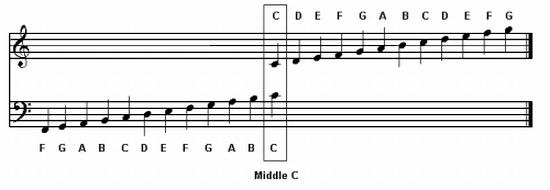Section 2: Treble clef
Take a look at Figure B. It is the D Major scale in Treble clef. We know it is the D major scale because of the accidentals at the beginning of the staff. The D major scale is marked by two accidentals - the sharp accidental placed on the space for the C note, and sharp accidental on the space for the F note.
If you think back to the first few chapters you will remember that in Treble clef, the solid lines from the bottom to the top represent the notes the E, G, B, D, and F, (easily remembered by the phrase "Every Good Boy Does Fine"). Going back to Figure A, (The Grand Staff), you would have noticed that there are two Treble staves, (most often used for harmony and melody).

Figure B (The Treble clef)
What makes the Treble clef most unique is pitch. On the grand staff the Treble clef is the highest in pitch, (there are a few, rare exceptions). The symbol for the Treble clef is unmistakable as it closely resembles the "&" symbol. By definition the Treble clef is also called the G clef because it indicates that the second line from the bottom of the staff represents the pitch of G above Middle C.

Figure C (Middle C)
Take a close look at Figure C. It shows the relationship between the Treble clef and Bass clef. More importantly it shows us Middle C. Notice that the Treble staff is above the Middle C position. On the Treble staff, look at the placement of the G note. It is easy to see why the Treble clef is called the G clef - from the bottom of the staff, the second line up is the G line, or by following the definition as given, it is "the pitch of G, above Middle C."